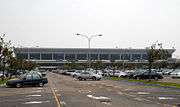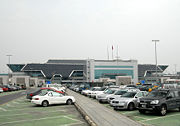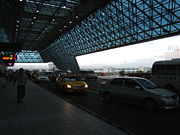Taiwan Taoyuan International Airport
| Taiwan Taoyuan International Airport 臺灣桃園國際機場 Táiwan Táoyuán Gúojì Jichǎng |
|||
|---|---|---|---|
|
|
|||
| IATA: TPE – ICAO: RCTP | |||
| Summary | |||
| Airport type | Public | ||
| Operator | Civil Aeronautics Administration | ||
| Serves | Taipei | ||
| Location | Taoyuan County, Taiwan | ||
| Elevation AMSL | 119 ft / 33 m | ||
| Runways | |||
| Direction | Length | Surface | |
| ft | m | ||
| 6/24 | 10,991 | 3,350 | Paved |
| 5/23 | 12,008 | 3,660 | Paved |
Taiwan Taoyuan International Airport (IATA: TPE, ICAO: RCTP) (traditional Chinese: 臺灣桃園國際機場; simplified Chinese: 台湾桃园国际机场; Tongyong Pinyin: Táiwan Táoyuán Gúojì Jichǎng, Hanyu pinyin: Táiwān Táoyuán Gúojì Jīchǎng), formerly Chiang Kai-shek International Airport (traditional Chinese: 中正國際機場; simplified Chinese: 中正国际机场; Tongyong Pinyin: Jhongjhèng Gúojì Jichǎng; Pinyin: Zhōngzhèng Gúojì Jīchǎng), also known simply as Taoyuan Airport, is an international airport located in Taoyuan County, Taiwan (Republic of China). It is one of three Taiwanese airports with regular international flights, and is by far the busiest international air entry point amongst them. It is the home base for China Airlines and EVA Air, which both operate a major hub at this airport.
Taiwan Taoyuan International Airport is one of the two airports that serve northern Taiwan, including Taipei. The other is Taipei Songshan Airport located within the Taipei City limits, which serves only domestic flights and rarely, some special international mission flights for the President and Vice President of the Republic of China as well as other international sovereignties' chartered flights. Taipei Songshan Airport formerly served Taipei as its international airport before the opening of Taiwan Taoyuan International Airport, then known as Chiang Kai-shek International Airport, in 1979. The other two airports with regular international flights in Taiwan are Kaohsiung International Airport (Hsiaogang Airport) and Taichung International Airport, while Hualien Airport and Makung Airport are allowed and occasionally offer international charters.
Contents |
Origin of the name
The airport, planned as the Taoyuan International Airport, bore the name of late President of the Republic of China Chiang Kai-shek until 2006. In Chinese its former name was literally "Chung-Cheng (Zhongzheng) International Airport", where Chung-Cheng is the legal given name which Chiang Kai-shek had used since 1910s. In a situation roughly analogous to those affecting Ronald Reagan-Washington National Airport and, for many years, Cape Kennedy in the US, political associations connected with the name led some people to avoid using it. In Taiwan Chiang Kai-shek is associated with the Chinese Nationalist Party or Kuomintang and its many years of one-party authoritarian rule. Local officials in Taoyuan County and members of the pan-Green coalition often referred to the hub by the name originally associated with it, "Taoyuan International Airport." News organizations and local residents sometimes combined the two commonly used names as "Taoyuan Chung-Cheng Airport."
The Executive Yuan of then-President Chen Shui-bian's administration officially approved the name Taiwan Taoyuan International Airport for the hub on September 6, 2006[1]. The opposition Kuomintang, which together with its political allies held a one-vote majority in the Legislative Yuan, decried the change and proposed "Taiwan Taoyuan Chiang Kai-shek International Airport" instead[2]. The disagreement, like those affecting the names of the Chiang Kai-shek Memorial Hall and other Taiwan landmarks, stands as another manifestation of the trend known as Taiwan localization among pan-Green officials and desinicization by Pan-blue coalition.
In mainland China, the mainland Chinese media has always referred to the airport as "Taoyuan International Airport" so as to avoid mention of Chiang Kai-Shek.
History
The airport opened (with Terminal 1) on February 21, 1979 as part of the Ten Major Construction Projects pursued by the government in the 1970s. The airport was originally planned under the name Taoyuan International Airport but was later changed to Chiang Kai-shek International Airport in memory of former President of the Republic of China Chiang Kai-shek.
The airport is the main hub of China Airlines, the ROC's flag carrier, as well as EVA Air, a private airline established in the early 1990s. Overcrowding of the airport in recent years prompted the construction of Terminal 2, which was opened on July 29 2000 with half of the gates operational. EVA Air was the first airline to move into Terminal 2. The other half opened on January 21, 2005 for China Airlines[3]. There are plans for the construction of a third terminal, which will be built as a replacement for the aging Terminal 1. It is rumored that all international flights will be moved to Terminal 3 and Terminal 1 will be renovated into a domestic terminal. Construction on Terminal 3 is expected to begin in 2008[4].

An extension of the Taipei Rapid Transit System will link all the airport's terminals together, as well as link the airport to Taipei City.
In January 2006, a Foreign Laborers' Service Center was set up[5] to provide airport pick-up services and serve the needs of migrant workers. There are service desks in the Arrival lobby of Terminal 1 and Terminal 2, and in the Departure lobby of Terminal 1. Service hotlines in the Vietnamese, Thai, English, and Indonesian languages are provided.
Incidents
On November 28, 1987, South African Airways Flight 295 crashed in a catastrophic fire on the Indian Ocean off Mauritius bound to Jan Smuts Airport (now OR Tambo International Airport) in Johannesburg from Chiang Kai-Shek Airport, as it was known then. All 159 passengers and crew killed.
Taiwan Taoyuan International Airport was one of the airports targeted by the failed Project Bojinka plot in 1995.
On February 16, 1998, China Airlines Flight 676, which was arriving from Denpasar-Bali International Airport, Indonesia, crashed into a residential area while landing in poor weather, killing all 196 people on board and six on the ground.
On October 31, 2000, Singapore Airlines Flight 006, which was on a Singapore Changi Airport, Singapore-Taipei-Los Angeles International Airport, Los Angeles route rammed into construction equipment on a closed runway 05R during takeoff from Taipei. The aircraft had lifted off and crashed with 82 fatalities. At the time of the incident, the northern runways were designated 05L and 05R (parallel); the latter has since been reassigned as a taxiway.
On May 25, 2002, China Airlines Flight 611 broke up in mid-flight on the way to Hong Kong International Airport in Hong Kong from Chiang Kai-Shek Airport, as it was known then. All 225 people on board died.
Airlines and destinations
| Destinations by Region |
|---|
|
Terminal 1

Terminal 1 is the original passenger terminal of the Taiwan Taoyuan International Airport. The terminal, along with the airport, opened in 1979 as a relief to the overcrowded Taipei Songshan Airport. All international flights moved to the airport following the completion of this terminal. Terminal 1 featured 22 gates. A row of 11 gates are located on the north end of the airfield facing the north runway and another row of 11 gates are located on the south end airfield facing the south runway. The two concourses that contained the airplane gates are linked together by a main building that contained the check-in areas, baggage claim, passport immigration areas, and security checkpoint areas. Together they form a giant "H". All gates are equipped with jetways. Gates located at the end of the concourses have one jetway and gates not located at the end of the concourses have two jetways. The terminal used to be very white in color when it first opened. As the years gradually passed, the facade and color is becoming more tan and yellow colored due to the overwide pollution in Taipei.
Terminal 1 is also currently undergoing a $42 million dollar renovation that is expected to be completed by 2010. The renovation includes a new facelift, designed by Japanese architect Norihiko Dan, and a new modern and stylish interior. The renovation will be completed during late hours to avoid congestion during peak hours.
The design of Terminal 1 was based on the main terminal of the Washington Dulles International Airport.
After Terminal 2 was completed, some gates from Terminal 1 were removed to make space for Terminal 2. Currently Terminal 1 has 18 gates[6].
Alphabetical letters were introduced when Terminal 1 was completed. The north concourse is now Concourse A and the south concourse is now Concourse B. Before Terminal 2, gates were numbered from 1 to 22.
China Airlines flights to and from Europe, Southeast Asia, and South Korea are located in Terminal 1.
Airlines using this terminal:
- Air Macau (Macau)
- Cathay Pacific (Fukuoka, Hong Kong, Nagoya-Centrair, Osaka-Kansai, Seoul-Incheon, Tokyo-Narita)
- Cebu Pacific (Manila)
- China Airlines (Abu Dhabi, Amsterdam, Bangkok-Suvarnabhumi, Cebu [begins 6 December], Chiang Mai, Delhi, Denpasar/Bali, Frankfurt, Hanoi, Ho Chi Minh City, Hong Kong, Jakarta, Kaohsiung, Kuala Lumpur, Manila, Palau, Penang, Phnom Penh, Phuket, Rome-Fiumicino, Seoul-Incheon, Singapore, Surabaya, Vienna, Yangon [begins 6 December])
- Jetstar Asia (Singapore)
- Korean Air (Seoul-Incheon)
- Malaysia Airlines (Kota Kinabalu, Kuala Lumpur, Los Angeles)
- Mandarin Airlines (Borcay, Asahikawa, Hakodate, Kaohsiung)
- Philippine Airlines (Manila)
- Thai Airways International (Bangkok-Suvarnabhumi, Hong Kong, Phuket, Seoul-Incheon)
- TransAsia Airways (Busan, Jeju, Macau, Muan)
- Vietnam Airlines (Hanoi, Ho Chi Minh City)
Terminal 2




Terminal 2 opened in 2000 to reduce congestion in the aging Terminal 1. Only the South Concourse had been completed by the time the terminal opened. The South Concourse alone has 10 gates, each with 2 jetways and their own security checkpoints. The North Concourse opened later in 2005, bringing the total number of gates for Terminal 2 to 20 gates; the security checkpoints were moved to a central location in front of the passport control.
The Southern and Northern Concourses are also known as Concourse C and Concourse D, respectively. Terminals 1 and 2 are connected by two short people mover lines, with one from Concourse A to D, and the other from B to C.
China Airlines flights to and from the US, Canada, Australia, Japan, Guam and cross-strait charter (Beijing, Guangzhou and Shanghai-Pudong) are located in Terminal 2.
Airlines using this terminal:
- Air China (cross-strait charter) (Beijing, Shanghai-Pudong)
- All Nippon Airways (Nagoya-Centrair, Tokyo-Narita)
- Asiana Airlines (Seoul-Incheon)
- China Airlines (Anchorage, Beijing (cross-strait charter), Brisbane, Fukuoka, Guam, Guangzhou (cross-strait charter), Hiroshima, Honolulu, Los Angeles, Nagoya-Centrair, Nanjing (cross-strait charter), New York-JFK, Okinawa, Osaka-Kansai, San Francisco, Sapporo-Chitose, Shanghai-Pudong (cross-strait charter), Sydney, Tokyo-Narita, Vancouver)
- China Eastern Airlines (cross-strait charter) (Kunming, Shanghai-Pudong, Wuhan)
- China Southern Airlines (cross-strait charter) (Guangzhou)
- Dragonair (Hong Kong)
- EVA Air (Amsterdam, Bangkok-Suvarnabhumi, Beijing (cross-strait charter), Brisbane, Denpasar/Bali, Fukuoka, Guangzhou (cross-strait charter), Hanoi, Ho Chi Minh City, Hong Kong, Jakarta, Komatsu, Kuala Lumpur, London-Heathrow, Los Angeles, Macau, Manila, Miyazaki, Nagoya-Centrair, Newark, Osaka-Kansai, Paris Charles-de-Gaulle [begin 21 January], Phnom Penh, San Francisco, Sapporo-Chitose, Seattle/Tacoma, Sendai, Seoul-Incheon, Shanghai-Pudong (cross-strait charter), Singapore, Surabaya, Tokyo-Narita, Vancouver, Vienna)
- Japan Airlines (Nagoya-Centrair, Osaka-Kansai, Tokyo-Narita)
- KLM (Amsterdam, Bangkok-Suvarnabhumi)
- Mandarin Airlines (cross-strait charter) (Beijing, Guangzhou)
- Northwest Airlines (Detroit [ends 2 March], Osaka-Kansai [ends 2 March], Tokyo-Narita)
- Singapore Airlines (Singapore)
- United Airlines (Tokyo-Narita)
- Uni Air (cross-strait charter) (Shanghai-Pudong, Kaohsiung)
Cargo airlines
- Air Macau (operated by Tradewinds Airlines)
- Atlas Air (operated for Emirates Airline)
- Cargolux (Bangkok, Baku, Budapest, Kuwait, Luxembourg)
- Cathay Pacific Cargo
- China Airlines Cargo (Abu Dhabi, Anchorage, Atlanta, Bangkok-Suvarnabhumi, Dallas/Fort Worth, Houston-Intercontinental, Kuala Lumpur, Luxembourg, Manchester, Nashville, Stockholm-Arlanda)
- DHL (operated by Air Hong Kong)
- Dragonair
- EVA Air Cargo
- FedEx Express
- Japan Airlines (Osaka-Kansai,Tokyo-Narita)
- MASkargo (Kuala Lumpur)
- Northwest Airlines
- Pacific East Asia Cargo Airlines (Manila-Clark)
- Singapore Airlines Cargo
- TransGlobal Airways (Manila-Clark)
- UPS Airlines
Ground Transportation
- Bus:Frequent buses link this airport to Taipei, Taoyuan, Jhongli, Taichung and Taiwan High Speed Rail's Taoyuan Station. Bus stops are available at both terminals.
- Car Rental: Available at both terminals. This airport is served by National Highway No. 2.
- Railway: The Taoyuan International Airport Access MRT System is scheduled to begin service in 2010.
Aviation Museum
The Chung Cheng Aviation Museum (traditional Chinese: 中正航空科學館) is located on the south-eastern area of the airport between the main freeway entrance and the terminals. It was built in 1981 by Boeing under CAA contract[7]. Many retired Republic of China Air Force fighters are represented here. The Chung Cheng Aviation Museum is the only major aviation museum in Taiwan.
See also
- Kaohsiung International Airport
- Taipei Songshan Airport
- Transportation in Taiwan
- Ten Major Construction Projects
References
- ↑ "Signboard replacement to reflect airport name-change gets underway" (2006-09-06). Retrieved on 2006-09-06.
"Cabinet approves new name for Taiwan's main international airport" (2006-09-06). Retrieved on 2006-09-06.
ATVnews (Hong Kong, Traditional Chinese)
BBC (Traditional Chinese) - ↑ "CKS AIRPORT SHOULD BE RENAMED 'TAIWAN TAOYUAN CKS AIRPORT': KMT" (2006-09-01). Retrieved on 2006-09-03.
- ↑ China Airlines (2005-01-25). "About the D Concourse of Terminal 2". China Airlines. Retrieved on 2006-05-21.
- ↑ Airport Technology (2005-01-25). "Terminal 3 Information". Airport Technology. Retrieved on 2006-05-21.
- ↑ Chiang Kai-Shek International Airport (2006-01-20). "Opening of Foreign Laborer’s Service Center". Chiang Kai-Shek International Airport. Retrieved on 2006-05-19.
- ↑ "Taipei Taoyuan International Airport- Basic Information".
- ↑ Museum Info - Taoyuan County Government Website (Trad. Chinese)
External links
- Taiwan Taoyuan International Airport Homepage
- AirlineSafety.com: Rushing to Die: Flight SQ006
- Taiwan:Touch Your Heart
|
|||||||||||||||||
